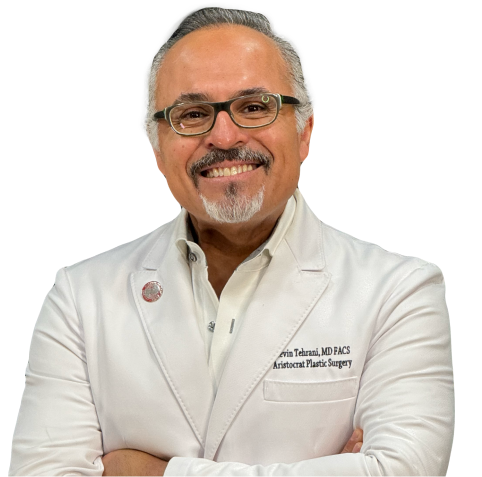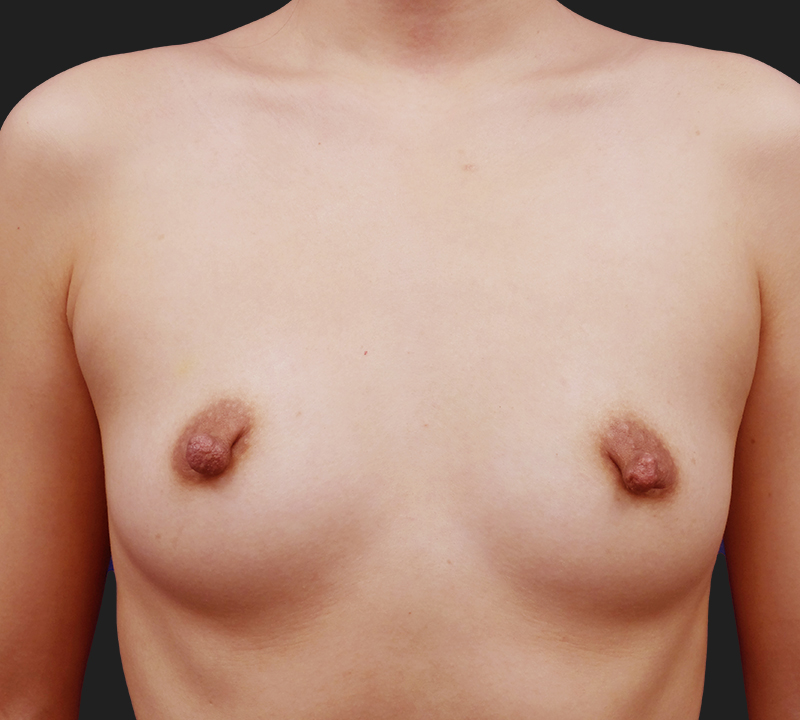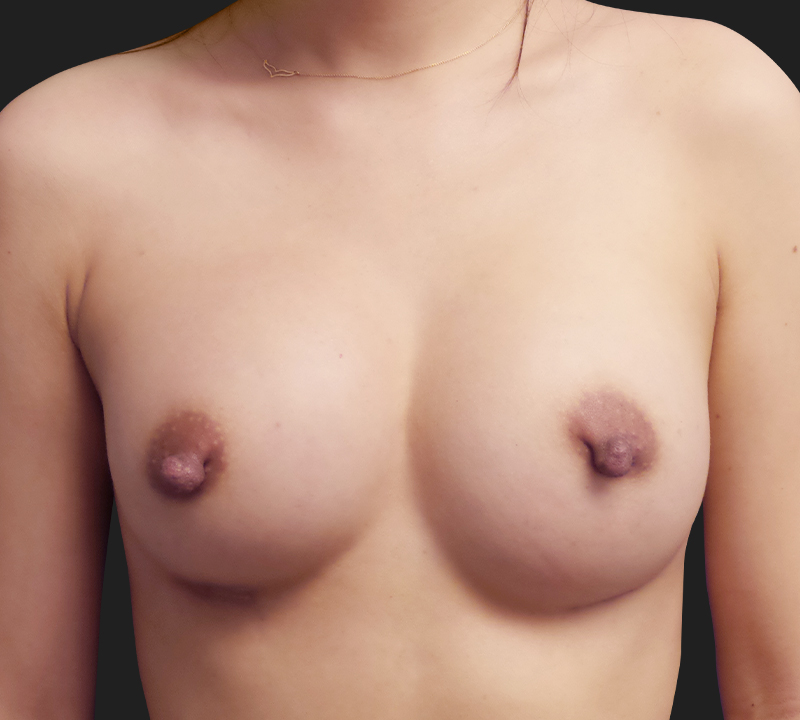Breast Augmentation with Anatomical Implants

Are Anatomical Implants Right For You?
Breast augmentation has provided many women with increased self-confidence, better figure proportion, and improved body image*. Women report that clothes fit better, and they no longer feel self-conscious about their breast size and shape*. This surgical procedure enhances the size and shape of the breasts by inserting implants under or over the pectoral muscles.
Anatomical implants are contoured rather than round, fuller on the bottom/base and less full on the top like the anatomical shape of the natural breast. This is sometimes called “teardrop shape.” Originally, these implants were used for breast reconstruction after a mastectomy, but it became obvious that many women would prefer them for cosmetic breast augmentation as well.
Another advantage of anatomical implants is that they can be customized for you, and they come with saline, silicone, and gummy bear fillings. You can choose from different profiles and heights, which we will discuss with you during your consultation.
Using our VECTRA 3D imaging technology, you will be able to “try on” different sizes and shapes and decide on the implant you want. If you desire maximum cleavage, for example, a round implant may be a better option for you.
Anatomical implants have textured shells. This allows the shell to adhere to the tissue within the pocket where the implant resides, and the adherence prevents the implant from turning. If a round implant turns, there is no visible change because it is symmetrical all around. If a teardrop-shaped implant turns, the full portion could move to the top and the less full portion could end up on the bottom, creating a deformed shape. The texture of the shell avoids this occurrence and also makes the implant less prone to capsular contracture (scar tissue that causes the implant to become hard).
Because the implants are not round, their placement is more complex, so you need a surgeon who has considerable experience in working with these types of implants. The pocket that is created for the implant, for example, is not the same as in other breast augmentation techniques. Dr. Kevin Tehrani has many years of experience providing women with successful anatomical breast implant surgeries. With his expertise, your implants will last a very long time.
If your breasts have also begun to sag due to pregnancy, breastfeeding, age, or genetics, you can have a breast lift concurrent with your anatomical breast enhancement surgery. Breast augmentation has provided many women with increased self-confidence, better figure proportion, and improved body image*. Women report that clothes fit better, and they no longer feel self-conscious about their breast size and shape*. This surgical procedure enhances the size and shape of the breasts by inserting implants under or over the pectoral muscles.
Anatomical implants are contoured rather than round, fuller on the bottom/base and less full on the top like the anatomical shape of the natural breast. This is sometimes called “teardrop shape.” Originally, these implants were used for breast reconstruction after a mastectomy, but it became obvious that many women would prefer them for cosmetic breast augmentation as well.
Another advantage of anatomical implants is that they can be customized for you, and they come with saline, silicone, and gummy bear fillings. You can choose from different profiles and heights, which we will discuss with you during your consultation.
Because the implants are not round, their placement is more complex, so you need a surgeon who has considerable experience in working with these types of implants. The pocket that is created for the implant, for example, is not the same as in other breast augmentation techniques. Dr. Kevin Tehrani has many years of experience providing women with successful anatomical breast implant surgeries. With his techniques, your implants will last a very long time.
If your breasts have also begun to sag due to pregnancy, breastfeeding, age, or genetics, you can have a breast lift concurrent with your anatomical breast enhancement surgery.
read more

Who Is A Candidate for Anatomical Implants?
Candidates include women who feel their breasts are too small, women who have experienced a reduction in breast volume after pregnancy, or women with breasts that do not match in size or shape, but who wish to have a teardrop-shaped implant. Breast augmentation with anatomical implants is a common choice after pregnancy and breastfeeding when breasts often lose their original and youthful look and shape.
The surgery is performed on adults, usually no sooner than age 17 or 18. Rarely, the surgery may be performed at an earlier age if the patient is suffering emotionally from extreme asymmetry of her developing breasts.
Why do women seek breast augmentation with anatomical implants?
- Enlargement of small breasts but a desire for a very natural look
- Balancing of breasts that differ in size and/or shape
- Reshaping of breasts that are misshapen
- Reshaping and enlarging of breasts that have lost their shape or fullness due to pregnancy or the aging process
read more

The Anatomical Breast Implant Procedure, also known as anatomical or teardrop-shaped implant surgery, is a surgical technique used to enhance the size and shape of a woman's breasts. This procedure is typically chosen by individuals who desire a more natural-looking breast augmentation result. Anatomical breast implants differ from traditional round implants in that they are designed to mimic the natural contours of the female breast, resembling a teardrop shape rather than a perfect circle.
Your surgery is usually performed under general anesthesia on an outpatient basis. Incisions can be placed under the natural crease of the breast or around the areolas that surround the nipples.
Dr. Tehrani generally places the implants under the muscle, which he believes offers his patients a better result, including less risk of a scar capsule developing around the implant.
Here is an overview of the Anatomical Breast Implant Procedure:
- Consultation: The process begins with a consultation with Dr. Tehrani. During this consultation, the patient discusses their goals and expectations for breast augmentation. Dr. Tehrani evaluates the patient's anatomy and helps them choose the appropriate implant size and shape.
- Pre-operative preparation: Before the surgery, the patient may be required to undergo various pre-operative tests, and their surgical plan is finalized. This includes selecting the ideal implant size, shape, and placement, as well as discussing incision options.
- Anesthesia: The procedure is typically performed under general anesthesia to ensure the patient's comfort and safety during the surgery.
- Incision: Dr. Tehrani makes an incision in a discreet location, often in the inframammary fold (the crease under the breast), around the areola, or in the axilla (armpit). The choice of the incision location depends on the patient's anatomy and preferences.
- Implant placement: The anatomical breast implant is carefully inserted through the incision and positioned either behind the breast tissue or beneath the chest muscle (subglandular or submuscular placement). Dr. Tehrani adjusts the implant to achieve the desired shape and symmetry.
- Suturing and closure: Once the implant is in place, Dr. Tehrani sutures the incision closed with fine, dissolvable stitches. Surgical tape or adhesive strips may be used to support the incision as well.
Anatomical breast implants are designed to provide a more natural look, with a gradual slope and fuller projection in the lower part of the breast, mimicking the appearance of natural breast tissue.
Another technique is the TUBA procedure. Dr. Tehrani will discuss the incision and placement options with you prior to your surgery and make recommendations that are specific to your case.
It's important to note that the success and satisfaction of this procedure depend on the skill and experience of the surgeon, proper implant selection, and realistic patient expectations.
Potential risks and complications associated with breast augmentation surgery should be thoroughly discussed during your consultation to ensure that patients make informed decisions about their desired outcomes
read more
What Is The Anatomical Breast Implant Procedure
Types of Breast Augmentation Procedures
Silicone Implants
Breast augmentation with silicone implants is one of the most popular procedures Dr. Kevin Tehrani perform at Aristocrat Plastic Surgery & MedAesthetics. Silicone implants come in various shapes and sizes and consist of silicone gel and silicone case. Silicone is a synthetic material that feels similar to human fat, that’s why silicone implants feel so soft and natural when used for breast augmentation. Famous “gummy bear implants” are highly cohesive silicone gel implants. They are known to retain their shape better than other implants.read more
Shaped Implants
Shaped silicone breast implants are also known as “Teardrop” implants. Unlike smooth round implants, these implants are shaped like a teardrop (thinner at the top than the bottom) and are designed to provide a better projection to the breasts.
Transumbilical Breast Augmentation
Transumbilical Breast Augmentation (TUBA) is the breast augmentation technique when breast implants are placed through an incision in the belly button leaving no visible scars on the body. This method of breast augmentation is associated with minimal pain and a faster recovery.

Meet Dr. Kevin Tehrani, MD FACS
Contact Us
"*" indicates required fields
Frequently
Asked Questions
How do saline implants differ from silicone implants?
They’re filled with sterile saltwater after insertion, and can be adjusted for volume during surgery.
Are they less expensive?
Generally, saline implants cost a bit less than silicone implants.
What happens if a saline implant ruptures?
The implant deflates quickly, and the body absorbs the saltwater safely, making it easy to detect.
Do saline implants feel natural?
They can feel slightly firmer or have more rippling if the patient has thin breast tissue.
Where is the incision placed?
Often in the inframammary fold or around the areola; the implant is filled once in place, allowing smaller incisions.




